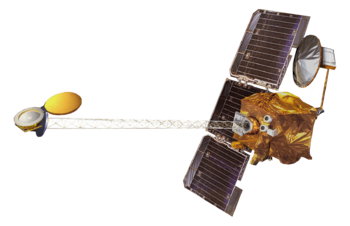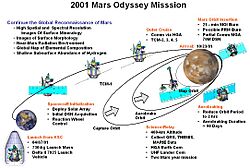2001 Mars Odyssey facts for kids

Artist's impression of the Mars Odyssey spacecraft
|
|
| Mission type | Mars orbiter |
|---|---|
| Operator | NASA / JPL |
| Mission duration |
|
| Spacecraft properties | |
| Manufacturer | Lockheed Martin |
| Launch mass | 725 kg |
| Dry mass | 376.3 kilograms (830 lb) |
| Power | 750 W |
| Start of mission | |
| Launch date | April 7, 2001, 15:02:22 UTC |
| Rocket | Delta II 7925-9.5 |
| Launch site | Cape Canaveral SLC-17A |
| Contractor | Boeing |
| End of mission | |
| Last contact | Q4 2025 (planned) |
| Orbital parameters | |
| Reference system | Areocentric |
| Regime | Sun-synchronous |
| Semi-major axis | 3,793.4 km (2,357.1 mi) |
| Eccentricity | 0.0 |
| Altitude | 400 km (250 mi) |
| Inclination | 93.064° |
| Period | 2 hours |
| RAAN | 34.98° |
| Argument of periareion | 0° |
| Mean anomaly | 0° |
| Epoch | October 19, 2002 |
| Mars orbiter | |
| Orbital insertion | October 24, 2001, MSD 45435 12:21 AMT |

Mars Exploration Program
|
|
The 2001 Mars Odyssey is a robotic spacecraft that orbits the planet Mars. NASA developed this project. It cost about US$297 million to build and operate.
The main goal of Odyssey is to look for signs of past or present water and ice on Mars. It uses special tools like spectrometers and a thermal imager for this. The spacecraft also studies the planet's rocks and the amount of radiation there.
The information Odyssey collects helps scientists answer big questions. For example, did life ever exist on Mars? It also helps figure out how much radiation future astronauts might face. Odyssey also acts as a communication relay. It sends messages from rovers like Curiosity and previous landers to Earth. The mission was named to honor Arthur C. Clarke, who wrote the book 2001: A Space Odyssey.
Odyssey launched on April 7, 2001, from Cape Canaveral Air Force Station. It reached Mars on October 24, 2001. As of March 2025, it is still working and collecting data. Scientists believe it has enough fuel to keep going until the end of 2025. It holds the record for the longest-running spacecraft orbiting another planet besides Earth. It has been active for over 23 years.
In May 2002, Odyssey found large amounts of hydrogen on Mars. This was a big clue that ice might be hidden just below the surface. The orbiter then mapped where this water ice was located. It even found huge amounts of water ice near the equator of Mars.
Odyssey has also been very important for communication. It has served as the main way for NASA's Mars rovers and landers to send data back to Earth. This includes the Curiosity rover and earlier missions like the Mars Exploration Rovers.
Contents
Why the Name Mars Odyssey?
In August 2000, NASA asked people to suggest names for the mission. They received 200 ideas. The first name chosen was "Astrobiological Reconnaissance and Elemental Surveyor," or ARES. This name was a nod to Ares, the Greek god of war.
However, some people thought ARES was not very exciting or sounded too aggressive. So, the naming team met again. The name "2001 Mars Odyssey" had been considered before. But there were worries about copyright. NASA then contacted Arthur C. Clarke, the author. He was happy to have the mission named after his books. On September 20, the name was officially changed to 2001 Mars Odyssey.
Mission Goals
The Mars Odyssey mission has several important goals:
- To create maps showing the levels of different elements across the entire surface of Mars.
- To find out how much hydrogen is present just below the surface.
- To build a collection of detailed images and information about the minerals on Mars.
- To learn about the shape and features of the Martian surface.
- To measure the radiation levels around Mars. This helps understand the risks for future human explorers.
Science Tools on Board
Odyssey carries three main science instruments:
- Thermal Emission Imaging System (THEMIS): This is a camera that takes pictures using visible light and infrared light. It helps scientists see where different minerals are located on Mars.
- Gamma Ray Spectrometer (GRS): This tool looks for elements like carbon, silicon, iron, and magnesium in the Martian atmosphere. It includes a special part called the High Energy Neutron Detector (HEND), which was provided by Russia.
- Mars Radiation Environment Experiment (MARIE): This instrument measures the levels of radiation around Mars. It helps scientists understand how safe it would be for humans to visit Mars.
The Mission Journey
Mars Odyssey launched from Cape Canaveral on April 7, 2001. It traveled for about 200 days and arrived at Mars on October 24. When it got there, the spacecraft fired its main engine. This slowed it down enough to be captured by Mars' gravity and enter orbit.
Odyssey then spent about 76 days doing something called aerobraking. This means it used the very top part of Mars' atmosphere to slow down. By doing this, it gradually changed its orbit to be more circular. Using aerobraking saved a lot of fuel. This meant the mission could use a smaller, less expensive rocket.
Aerobraking finished in January 2002. Odyssey began its science mission on February 19, 2002. The original mission was planned to last until August 2004. But it has been extended many times and is still active today.
The MARIE radiation experiment stopped working on October 28, 2003. This happened after a large solar event hit the spacecraft. Engineers think a solar particle might have damaged a computer chip.
Odyssey has been a vital link for other Mars missions. About 85% of the images and data from NASA's rovers, Spirit and Opportunity, came to Earth through Odyssey. It also helped choose safe landing sites for these rovers and for the Phoenix mission in 2008. When the Mars Reconnaissance Orbiter arrived in 2006, Odyssey helped by watching the atmosphere during its aerobraking phase.
Odyssey is in a Sun-synchronous orbit. This means it passes over the same parts of Mars at the same local time each day. This provides consistent lighting for its cameras. In September 2008, the spacecraft changed its orbit slightly. This helped its infrared mapping tool get better data on Martian minerals.
By December 15, 2010, Odyssey became the longest-serving spacecraft at Mars. It had been operating for 3,340 days.
The orbiter uses three special wheels to control its direction. One of these wheels stopped working in June 2012. Luckily, there was a spare wheel, which was successfully started. Since July 2012, Odyssey has been back to full operation.
Mars Odysseys THEMIS instrument helped choose a landing site for the Mars Science Laboratory (MSL). Just before MSL's Curiosity rover landed in August 2012, Odysseys orbit was adjusted. This made sure it could pick up signals from Curiosity during its first moments on Mars. Odyssey also acts as a relay for Curiositys radio signals. Because of its orbit, Odyssey flies over Curiositys location twice a day. This allows regular communication with Earth.
In February 2014, mission control began to slowly change Odyssey's orbit. This change allowed it to observe how ground temperatures change after sunrise and sunset. These observations can help scientists learn about the ground's makeup. They can also study processes like warm seasonal flows on slopes and geysers near the poles.
On October 19, 2014, NASA confirmed that Mars Odyssey was safe after Comet Siding Spring flew by Mars.
In 2010, NASA thought Odyssey could work until at least 2016. This estimate has since been extended. It is now expected to continue operating until the end of 2025.
Major Discoveries
Mars Odyssey has made very important discoveries about Mars.
Finding Water Ice
By 2008, Mars Odyssey had mapped where water is located just below the surface. Its measurements were confirmed on July 31, 2008. The Phoenix lander found actual water ice on Mars. This was exactly where Odyssey had predicted it would be in 2002. Scientists are still trying to figure out if this water ice ever melts enough for tiny life forms to use. They also want to know if chemicals needed for life are present.
The orbiter also found huge amounts of water ice near the surface in areas around Mars' equator. Evidence for this water comes from both the shape of the land and the types of materials found. This was seen in places like the Medusae Fossae formation and the Tharsis Montes.
Images for kids
See Also
- Exploration of Mars
- List of Mars orbiters
- List of missions to Mars
- Mars Express Orbiter
- Mars Global Surveyor
- Mars Orbiter Mission
- Mars Student Imaging Project
- Mythodea – Music for the NASA Mission: 2001 Mars Odyssey







